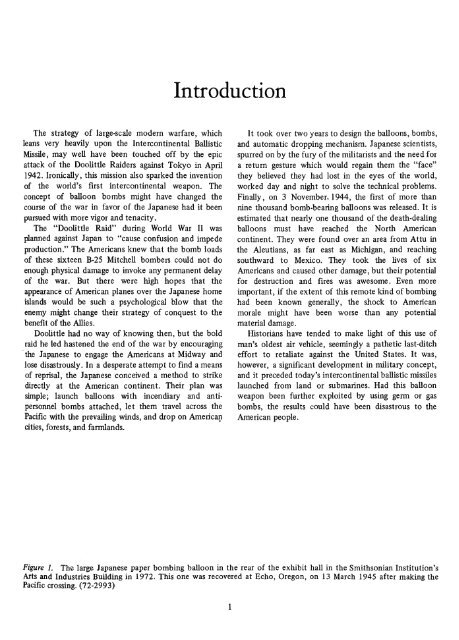Balloon Bomb - Smithsonian Institution Libraries
Balloon Bomb - Smithsonian Institution Libraries
Balloon Bomb - Smithsonian Institution Libraries
You also want an ePaper? Increase the reach of your titles
YUMPU automatically turns print PDFs into web optimized ePapers that Google loves.
Introduction<br />
The strategy of large-scale modern warfare, which<br />
leans very heavily upon the Intercontinental Ballistic<br />
Missile, may well have been touched off by die epic<br />
attack of the Doolittie Raiders against Tokyo in April<br />
1942. Ironically, this mission also sparked the invention<br />
of the world's first intercontinental weapon. The<br />
concept of balloon bombs might have changed the<br />
course of the war in favor of the Japanese had it been<br />
pursued with more vigor and tenacity.<br />
The "Doolittie Raid" during World War II was<br />
planned against Japan to "cause confusion and impede<br />
production." The Americans knew that the bomb loads<br />
of these sixteen B-25 Mitchell bombers could not do<br />
enough physical damage to invoke any permanent delay<br />
of the war. But there were high hopes that the<br />
appearance of American planes over the Japanese home<br />
islands would be such a psychological blow tiiat the<br />
enemy might change their strategy of conquest to the<br />
benefit of the Allies.<br />
Doolittle had no way of knowing then, but the bold<br />
raid he led hastened the end of the war by encouraging<br />
the Japanese to engage the Americans at Midway and<br />
lose disastrously. In a desperate attempt to find a means<br />
of reprisal, the Japanese conceived a method to strike<br />
directly at the American continent. Their plan was<br />
simple; launch balloons with incendiary and antipersonnel<br />
bombs attached, let them travel across the<br />
Pacific with the prevailing winds, and drop on American<br />
cities, forests, and farmlands.<br />
It took over two years to design the balloons, bombs,<br />
and automatic dropping mechanism. Japanese scientists,<br />
spurred on by the fury of the militarists and the need for<br />
a return gesture which would regain them the "face"<br />
they believed they had lost in die eyes of die world,<br />
worked day and night to solve the technical problems.<br />
Finally, on 3 November. 1944, the first of more than<br />
nine thousand bomb-bearing balloons was released. It is<br />
estimated that nearly one thousand of the death-dealing<br />
balloons must have reached die North American<br />
continent. They were found over an area from Attu in<br />
the Aleutians, as far east as Michigan, and reaching<br />
southward to Mexico. They took die lives of six<br />
Americans and caused otiier damage, but their potential<br />
for destruction and fires was awesome. Even more<br />
important, if die extent of this remote kind of bombing<br />
had been known generally, the shock to American<br />
morale might have been worse than any potential<br />
material damage.<br />
Historians have tended to make fight of this use of<br />
man's oldest air vehicle, seemingly a pathetic last-ditch<br />
effort to retaliate against the United States. It was,<br />
however, a significant development in military concept,<br />
and it preceded today's intercontinental ballistic missiles<br />
launched from land or submarines. Had this balloon<br />
weapon been further exploited by using germ or gas<br />
bombs, the results could have been disastrous to the<br />
American people.<br />
Figure 1. The large Japanese paper bombing balloon in the rear of the exhibit hall in the <strong>Smithsonian</strong> <strong>Institution</strong>'s<br />
Arts and Industries Building in 1972. This one was recovered at Echo, Oregon, on 13 March 1945 after making the<br />
Pacific crossing. (72-2993)<br />
1
















